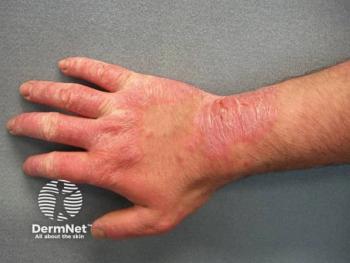
It's Not Genital Warts: A Clinician's Guide to Reassuring Men's Genital Concerns
Key Takeaways
- Dermatologists often reassure patients that benign genital conditions are not genital warts, alleviating anxiety.
- Common benign conditions mistaken for genital warts include Pearly Penile Papules, Tyson's glands, and Angiokeratoma of Fordyce.
In celebration of Men's Health Month, Hershel Dobkin, MD, FAAD, shed some light on a "taboo" topic.
Dr. Gregory House, from the hit television show, “House,” became famous for uttering the catchphrase, “It’s not Lupus!” This was in the context of him dismissing Lupus as a diagnosis to whichever medical mystery that was bestowed upon him and his fictional all-star team of specialist physicians.
Hershel Dobkin, MD, FAAD, despite being a former semi-okay-amateur-stand-up-comedian prior to being a dermatologist, sadly does not possess a mystery medicine television show. What he does possess is the experience of sometimes telling men that their genital skin area concern is not genital warts, also known as Condyloma Acuminatum, to those who enjoy proper medical terminology. And yes, of course both men and women can get genital warts, but in honor of men’s health month this commentary will focus on male patients, and the taboo around addressing their skin in sensitive areas.
Much of what a dermatologist does is reassure. There are numerous benign and lesser known cutaneous growths and anatomical variation that have designated diagnostic terms that can resemble Harry Potter spells, but nonetheless pose no medical threat to the patient. Polythelia -- the term for accessory nipple, Poikiloderma of Civatte -- skin changes on the neck due to longterm sun exposure, and Idiopathic Guttate Melanosis -- light spots on extremities from aging and longterm sun exposure, are all examples of diagnoses the non-dermatologist, when heard, may perceive as diseases, but are simply no immediate cause for concern.
Moving south or “inferior” in anatomical terms, we enter a differential diagnosis often clouded by emotions and embarrassment. In contrast to the “innocent until proven guilty” legal principle in our country’s justice system, genital concerns are “warts until proven not warts” to the vast majority of patients. Fleshy bump on genitals? Warts! Red bump on genitals? Warts! Occasional itch while staring down old men in the sauna? Warts! These are very real and common chief complaints men have presented with while concerned for genital warts.
It takes a great deal of vulnerability, courage, and overcoming of fear for many men to even mention a genital area skin issue, and as shocking as it may seem to the layperson, it’s a dermatologist’s job to treat this like any other skin complaint so as to prevent a “judgy” or awkward situation.
I am therefore granted the honor of reassuring many male patients, “It’s not genital warts.” Ironically, this reassurance that a patient’s perceived sexually transmitted infection is nothing but a benign growth or comparably harmless diagnosis creates a sense of emotional relief second only to telling a patient a lesion is not skin cancer. Nonetheless, that is what I and all dermatologists are here for.
There are more than a few notorious genital warts imposers that routinely cause unnecessary anxiety in men who come into our clinics. To expand on the “It’s not genital warts” differential, here are a few of the top offenders: To begin, we start with Pearly Penile Papules. These white papules straddling the penile corona are nothing but a type of angiofibroma-a benign growth of blood vessels and fibrous tissue. While we’re in the neighborhood, let’s discuss Tyson’s glands, yellow papules on the penis comprised of ectopic sebaceous (oil) glands. More subtlety different, the widely known diagnosis of acrochordons (skin tags) commonly masquerade as genital warts to the unseasoned condyloma eye (dermatologists). Lastly, and not as fleshy as the others, is the notorious Angiokeratoma of Fordyce-red or purple vascular red or purple papules often on the scrotum.
Once the emphatic relief from receiving a reassuring diagnosis passes on my male patient’s minds, there are a select few who ask the million-dollar question, “how do you know it’s not genital warts?” As with most other dermatological diagnoses, a dermatologist’s training and clinical experience is rooted in endless hours studying common and obscure dermatoses and pattern recognition in clinic settings across various skin types. The short answer to the above patient’s question would be, “Because I am a dermatologist,” but this might come across a tad bit pretentious. One day I may have enough dermatology “street cred” to answer this question with, “It’s not warts” while leaving the exam room like an 80s action hero walking away in slow motion from an explosion. The moral of this story is that a certain sensitive anatomical location shouldn’t hinder a concerned male patient from getting evaluated by a dermatologist -- it is all skin to us.
Newsletter
Like what you’re reading? Subscribe to Dermatology Times for weekly updates on therapies, innovations, and real-world practice tips.



















